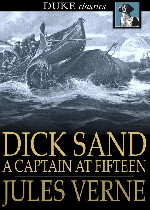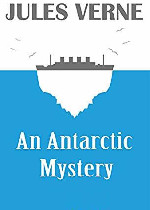
Isäntä ja renki Tolstoi(主人与仆人) 立即阅读
Se tapahtui 70-luvulla, talvella, Nikolainpäivän jälkeisenä päivänä. Pitäjäässä oli juhla ja kauppias Wasili Andrejitsh Brehunov, majatalon pitäjä, ei voinut olla poikessa, hänen kun kirkonisäntänä piti olla kirkossa ja sitte kotona ottaa vastaan ja kestitä sukulaisia ja tuttavia. Mutta niin pian kuin viimeiset vieraat olivat lähteneet pois, alkoi Wasili Andrejitsh heti hankkiutua matkalle naapuriin kartanon omistajan luo, jonka kanssa jo kauan oli eräästä metsästä kauppaa hieronut.

Dick Sand, A Captain at Fifteen(十五岁的小船长) 立即阅读
Dick Sand, A Captain at Fifteen (French: Un capitaine de quinze ans) is a Jules Verne novel published in 1878. Dick Sand is a fifteen-year-old boy that serves on the schooner Pilgrim, a whaler that normally voyages across the Pacific in their efforts to find targets. However, this time the hunting season has been unsuccessful, and as they plan to return home three people request passage to Valparaiso: Mrs Weldon, the wife of the hunting firm's owner, her five-year-old son Jack, his old nanny Nan and her cousin Bénédict, an entomologist. With not much of a choice, the captain accepts.

Cinq Semaines En Ballon(气球上的五星期) 立即阅读
Cinq semaines en ballon est un roman de Jules Verne, paru en 1863. Le roman est publié en édition in-18 le 31 janvier 1863 et a pour sous-titre Voyage de découvertes en Afrique par trois Anglais. La grande édition in-8o est mise en vente le 5 décembre 1865. Il s'agit du premier roman de Verne édité par Pierre-Jules Hetzel après le refus du Voyage en Angleterre et en Écosse. Verne y met au point les « ingrédients » de son œuvre à venir, mêlant avec habileté une intrigue féconde en aventures et en rebondissements de toutes sortes et des descriptions techniques, géographiques et historiques.

L’Île mystérieuse est un roman de Jules Verne, paru en 1875. Jules Verne publie en 1866-1868 Les Enfants du capitaine Grant, puis écrit Vingt mille lieues sous les mers paru en 1869. L'idée de traiter le cas d'un groupe de personnes abandonnées sur une île déserte est présente à son esprit depuis quelque temps. Dans les lettres qu'il écrit à son éditeur durant les années 1869 -1870, on perçoit qu'il travaille à ce projet. C'est ainsi qu'il propose à Jules Hetzel, en 1871, le roman L'Oncle Robinson qui décrit la survie d'un groupe de personnes aidées par un marin surnommé l'oncle Robinson.

An Antarctic Mystery(冰岛怪兽) 立即阅读
An Antarctic Mystery (French: Le Sphinx des glaces, The Sphinx of the Ice Fields) is a two-volume novel by Jules Verne. Written in 1897, it is a response to Edgar Allan Poe's 1838 novel The Narrative of Arthur Gordon Pym of Nantucket. It follows the adventures of the narrator and his journey from the Kerguelen Islands aboard Halbrane. Neither Poe nor Verne had actually visited the remote Kerguelen Islands, located in the south Indian Ocean, but their works are some of the few literary (as opposed to exploratory) references to the archipelago.

The Voyages and Adventures of Captain Hatteras(哈特拉斯船长历险记) 立即阅读
The Adventures of Captain Hatteras (French: Voyages et aventures du capitaine Hatteras) is an adventure novel by Jules Verne in two parts: The English at the North Pole (French: Les Anglais au pôle nord) and The desert of ice (French: Le Désert de glace). The novel was published for the first time in 1864. The definitive version from 1866 was included into Voyages Extraordinaires series (The Extraordinary Voyages). Although it was the first book of the series it was labeled as number two. Three of Verne's books from 1863-65 (Five Weeks in a Balloon, Journey to the Center of the Earth, and From the Earth to the Moon) were added into the series retroactively. Captain Hatteras shows many similarities with British explorer John Franklin.

Michael Strogoff: The Courier of the Czar (French: Michel Strogoff) is a novel written by Jules Verne in 1876. Critics, including Leonard S. Davidow,[1] consider it one of Verne's best books. Davidow wrote, "Jules Verne has written no better book than this, in fact it is deservedly ranked as one of the most thrilling tales ever written." Unlike some of Verne's other novels, it is not science fiction, but a scientific phenomenon (Leidenfrost effect) is a plot device. The book was later adapted to a play, by Verne himself and Adolphe d'Ennery. Incidental music to the play was written by Alexandre Artus in 1880.